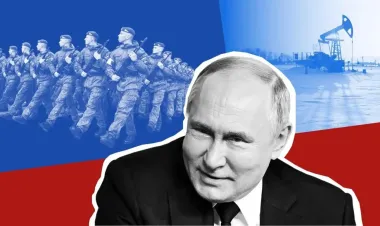Russia's tipping point: could war and recession break Putin's regime by 2026?

Russia is running out of money, soldiers and time. As the economy crumbles and the war in Ukraine continues, the cracks in Putin’s regime are deepening. Could 2026 see the collapse of Putin’s Russia?
[BANNER1]
The Russian economy is bleeding out
Since the annexation of Crimea in 2014, the Russian economy has experienced profound shocks which began with the implementation of Western sanctions and a seismic decrease of global oil prices. The economy fell into recession, and despite temporary rebounds, collapsed further with the renewed, full-scale invasion of Ukraine in 2022.
The start of Russia’s full-scale invasion of Ukraine on 24th February 2022 triggered an intense economic contraction, with Russia’s GDP reducing to 2.1% in 2022, which led to the Council of the European Union predicting a stagnation of the Russian economy, and even further decline in the coming years – which has occurred.
Meanwhile, Russia’s primary macroeconomic reserve, the National Wealth Fund (NWF), is being drained. Liquid assets – assets commonly set aside for crisis management – currently stands at a mere 1.5% of the GDP. Russia’s capital reserves are being exhausted, with many of the remaining assets taking the form of gold or the Chinese yuan, which are harder to allocate in times of crisis.
[BANNER2]
Despite efforts to bolster the economy such as macroprudential reforms and capital regulations – the pressure persists. In early 2025, inflation reached 10%. The rouble has strengthened considerably, having accelerated past the 78 mark to the dollar in May 2025. This means that the rouble’s value has increased by over 40% against the US dollar. The surge reflects political isolation and reduced demand for foreign currency – not real strength.
As the rouble strengthens, Russian exports have become less competitive and this has led to another observable economic contraction in the manufacturing industry. Unemployment rates are significant as factories dismiss staff at the fastest pace since April 2022.
The Russian labour market is imploding. Since 2022, it has been estimated that over 2 million migrants have fled Russia due to the renewed invasion of Ukraine, and over 640,000 soldiers of working age have been sent to the frontlines as of mid-May 2025. Some sectors hold numerous vacancies, but have been unable to locate qualified staff. Economist Yekaterina Kravcheko has labelled this to be a ‘perfect storm’.
Moscow continues to rely on modes of quasi-budgeting [funding strategies which do not relate to state budgets – they are often used to fund budget deficits]. Although, even this strategy is losing its efficiency. In 2025, Russia’s defence expenditure reached a leviathan ₽15.5 trillion (approximately £13.4 trillion). This is the highest defence budget Russia has had since the fall of the Soviet Union – and this caused the deficit to double to 1.7% of the GDP, having increased by 3.4% since 2024.
Putin's war machine is breaking down
Russia invaded Ukraine assuming to gain a quick victory. It didn’t. Now, three years later, it is haemorrhaging troops and equipment faster than it can recuperate.
From the onset, the war exposed deep-rooted flaws within Russia’s military planning structure. Logistics were neglected. Advancing troops ran out of equipment and food, supply lines weren’t secured, and soldiers were left to forage for their own supplies. The Kremlin’s four pillar supply strategy – overreach, consolidation, adaptation and currently attrition – has been unable to resolve the primary issue: Russia’s inability to supply a multi-axis protracted conflict.
Ukraine has adapted to the conflict with greater success and speed. Long-range missiles launched by Ukraine have destroyed Russian supply depots and transport routes. Moscow is rushing to recalculate its logistics before Ukraine and its allies destroy the Russian military entirely.
Russian losses have been significant. Analysts have predicted that Russia could lose over 1 million military personnel by the end of this year – if it hasn’t already. The state’s military strategy is reminiscent of the Stalinist quantity over quality approach, resulting in poorly trained conscripts taking up arms alongside professional soldiers – much like what took place during the Soviet period.
In trying to counteract such setbacks, Russia has worked to strengthen its military-technological relationship with China. Although China has supplied Russia with various critical technologies such as semiconductors, dual-use technologies and microchips, there are concerns within the Kremlin that China is potentially using and abusing Russian intelligence structures – representing a rather unequal trade off.
[BANNER3]
The Russian military is maximalist in nature. It prioritises numbers over precision and invests in emerging technologies considerably. The quick emergence of drone warfare and the integration of AI-enabled systems on the battlefield, has changed the character of the Russo-Ukraine war. Currently, Russia is in the process of field-testing MS001 drones. These are advanced drones which can strike targets autonomously and bypass conventional air defences.
However, the rate at which Russia is advancing in the technological realm is unsteady. Whilst some technologies such as the MS001 hold significant destructive capabilities, others have proved unreliable and inefficient. The emphasis placed upon AI and drones is a tacit recognition of Russia’s inability to reform its conventional forces and gain parity with the West.
Putin’s aims remain ambiguous. He commenced the renewed invasion claiming to be de-nazifying Ukraine. Currently, the objectives seem to regard territorial control, draining Western supplies, and reinstating Russian imperialism.Vague strategy exacerbates dysfunction.
Carl von Clausewitz warned that war which lacks clear political purpose and operational efficiency leads to disaster. Russia is strengthening his argument.

Why 2026 could be Putin's breaking point
If current trends hold, 2026 could see the collapse of Putin’s regime.
The liquid assets of the NWF are expected to be exhausted by mid-2026, defence expenditure is at a record high, inflation continues to grow, and industrial contraction is intensifying. The energy sector – once the foundation of the Russian economic and political structure – is subjected to Western sanctions, decreasing revenues and growing irrelevance.

[BANNER4]
Defence spending is subsuming the budgets of other sectors. Research and development is becoming ever more militarised, quashing generalised economic modernisation. Domestic debts are skyrocketing. Financial institutions are being pushed to their limits.
On the physical battlefield, Russia is bleeding resources and personnel. Supply shortages could reach determinative levels by the end of the year. Conversely, Ukraine is getting stronger and stronger.
Ukraine’s technological upperhand has been reinforced by the inclusion of advanced drones and artificial intelligence. Baykar, a Turkish defence company renowned for its Bayraktar drones, has commenced its construction of a factory near Kyiv, and production of the drones is to commence later this year. The factory in Kyiv is expected to produce approximately 120 combat drones annually, and employ 500 Ukrainian staff members – exemplifying defence cooperation between Ukraine and its international partners.
Europe is winning the long game, with the EU planning to halt all Russian gas imports by 2027, and the establishment of the new Defence Industrial Strategy strengthening the European Defence Technological and Industrial Base (EDTIB) – aiding Ukraine’s long-term war effort.
Russia, contrastingly, is expending capital, lives, and relations, at a pace that cannot be sustained.
What a Russian collapse means for Ukraine
If Russia’s fiscal exhaustion continues to intensify and the military fully collapses, Ukraine must prepare for both danger and opportunity.
History shows that weakened states have a tendency to act more unpredictably and severely. Russia may follow this pattern, signalling a further departure from conventional warfare towards continued, vehement systemic destruction of civilian infrastructure – or even attempts to expand operations beyond Ukraine. This would result in Russia depleting its resources at a more accelerated rate, giving Ukraine the upper hand and an opportunity to regain its temporarily occupied areas.
Power vacuums, regional instability or internal unrest could see Russia becoming increasingly erratic. However, with strong support from the West and continued ingenuity and determination – Ukraine is well positioned to tip the balance.
[BANNER5]
The next 12-18 months are crucial. If Ukraine continues to defend itself whilst Russia bleeds out, the conflict’s centre of gravity could in fact shift permanently in Ukraine’s favour.
2026 won’t just be a year of Ukraine withstanding Russian aggression. Ukraine may be placed in prime position to become a leading regional power, with accelerated EU ascension and the re-laying of the foundations for affluence and growth.
2026 may not merely be the breaking point for Putin’s regime – it could be the turning point for Ukraine’s prosperous and sovereign future.
Carina Macdonald,
Intern of Ukrainska Pravda










